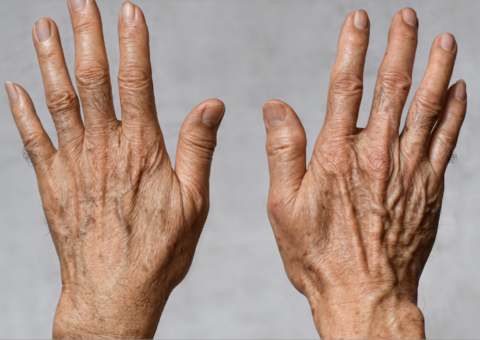
To fast or not to fast? If you’re asking whether intermittent fasting is for you, then here are 5 things to know with Stephanie Rouillard:

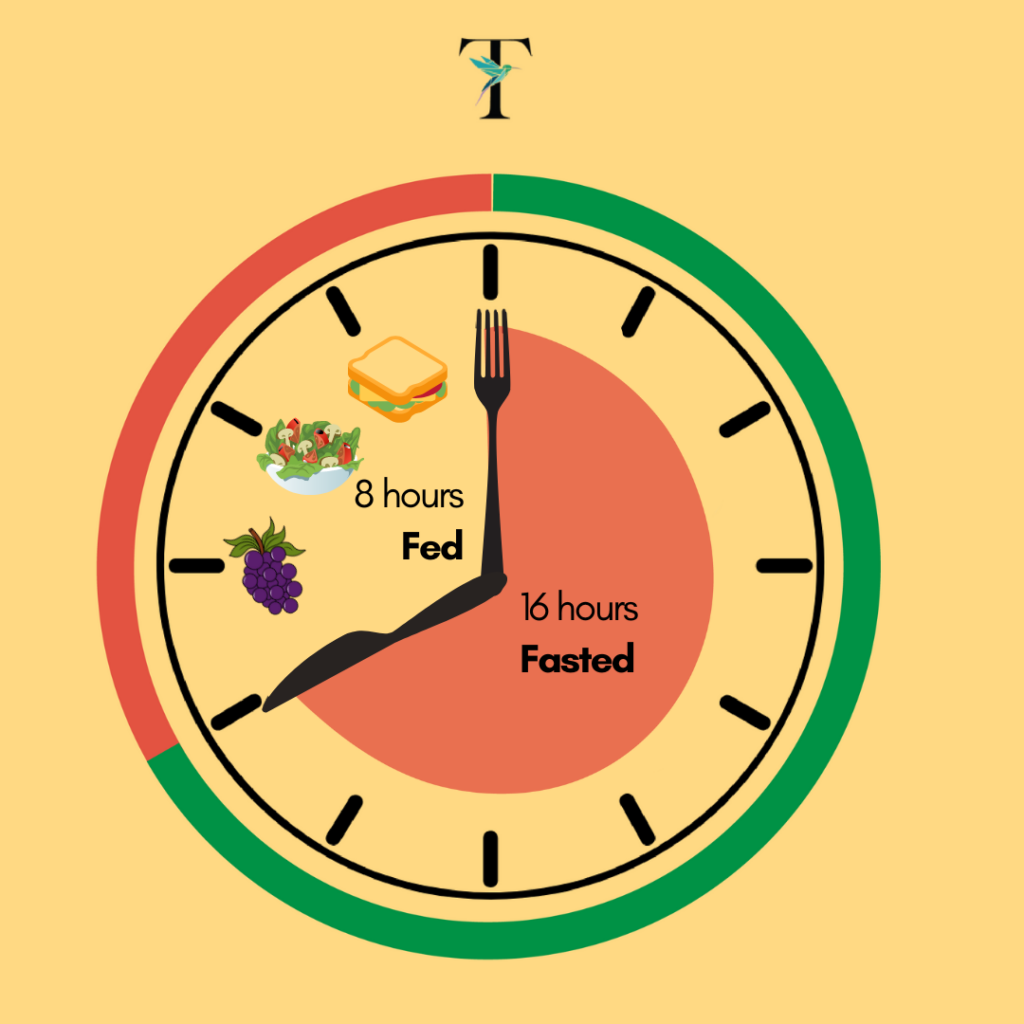
Fasting isn’t for everyone. If you’re pregnant, breastfeeding, still growing (that’s you, kids!) or underweight then fasting is a no-go. For type 1 or insulin-dependent diabetics, those with thyroid issues, or if you’re unsure whether fasting is contraindicated in your case; then it’s strongly advised that you stop by your integrative dietitian before implementing any fasting regime.
For the ‘healthy’ individual, the answer is ‘most likely’ according to science to date. Here are 3 promising benefits of fasting:
![]() It may promote longevity (hello, anti-aging!)
It may promote longevity (hello, anti-aging!)
Fasting acts as a moderate stressor on the body, just as moderate exercise or cold water immersion does, which kick starts your body’s protective mechanisms into ‘go mode’: Your cells ‘switch on’ many of their restorative or ‘healing’ mechanisms to promote:
- Autophagy: think of autophagy as your body’s ‘house-cleaning’ mode – when your body degrades ‘old’ cellular debris – out with the old, and in with the new! Perhaps your body likes doing house chores, more than you do?
- Antioxidant activity: fasting basically activates your body’s own internal antioxidant system. Yes, your body has the capacity to deal with harmful compounds (known as free radicals or ROS) all on its own, but it often requires a ‘wake-up call’ – hello fasting! You’ve probably heard of mitochondria, too? Think of the mitochondria as ‘battery packs’ in your cells. They produce energy from food, but also are the main guys who do the ‘sweeping up’ of all those ROS. Fasting has been shown to increase mitochondrial numbers and efficiency. Mitochondrial quality has been associated with improved heart, immune, gut, brain and skin health. Hands up if you want some of that?
- Anti-inflammatory effects: we all want to ‘put out’ that raging fire in the body; which is ignited by stress, inflammatory foods or environmental toxins. Fasting signals to your body to release its fire brigade. For the sciency people: fasting inhibits nuclear factor-κB (NF-κB) and activates nuclear factor-like 2 (Nrf2) to induce wide-spread anti-inflammatory effects.
![]() It may promote weight loss
It may promote weight loss

Fasting can reduce energy intake (or calories taken in) by decreasing the amount of food consumed daily, reducing cravings and appetite. In individuals who require weight loss interventions, fasting may allow for a more sustainable manner to maintain caloric restriction.
![]() It allows for metabolic flexibility
It allows for metabolic flexibility
Simply put: metabolic flexibility refers to your body’s ability to switch between using sugar as fuel, and using fat as fuel.
In pre-industrial times – before we had restaurants and grocery stores – humans were metabolically flexible by necessity. Some days there was plenty of food, and other days there wasn’t enough to go around. Metabolic Flexibility allowed people to go days without eating and feel fine. They were able to ‘dig into’ their fat stores easily in a fasted state, and sustain themselves on fat reserves – otherwise known as a state of ketosis.

Unfortunately, we’re not so good at this. Scientists put it down to modern diets – too high in carbs, processed sugars and alcohol; frequent eating or overeating – spending most of our time in the fed-state; and raised whole-body inflammation – associated with insulin resistance, as a result of frequent spikes in blood sugar levels. To learn about insulin-blood sugar link, read here.

In the world of fasting, there’s a regimen for everyone.
When we talk ‘fasting’, we’re often referring to time-restricted feeding (TRF). Typically; TRF involves eating all meals in a 6- to 8-hour window period, allowing for 14- to 16-hours of fasting.
Other example of fasting include:
- Alternate day fasting (ADF):
Fast (no caloric intake) every other day, while eating as per usual on non-fasting
- Modified Alternate Day Fasting (mADF):
Very limited caloric intake (500 – 600 kcal) on fasting days, while eating as per usual on non-fasting
- 5:2 protocol:
Restricted caloric intake (500 – 600 kcal) for 2 consecutive or non-consecutive days in the week, while eating with unrestricted or as per usual on the other 5 days of the week
- Prolonged fasting:
No caloric intake, except for water, for 3 days or more
- Short-term fasting:
No caloric intake, except for water, for 3 days or less
- Fasting Mimicking Diet (FMD)
A commercial diet consisting of plant-based, low protein, reduced caloric meal plan for 3 cycles, of 5 days per month
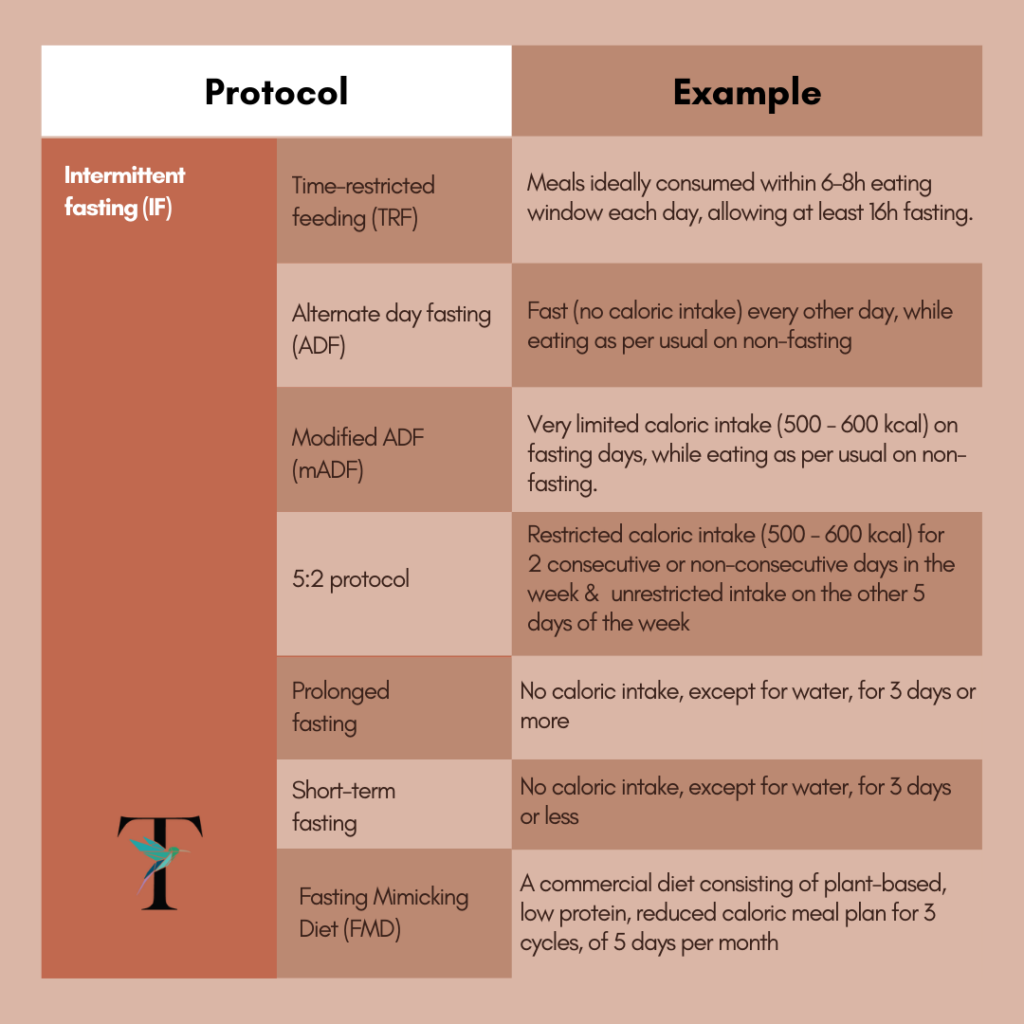

To date, head-to-head studies that compare different fasting regimes are ‘far and few between’. However, emerging research allows practitioners to make recommendations based on evidence.
But, more importantly, the best fasting regime is the one that can be maintained. Lifestyle and dietary changes need to be sustainable and ENJOYABLE. Secondly, your wellbeing is a dynamic state; and regimes may need to be modified according to your life stage, stressors and health concerns.
As a starting point, Time Restricted Feeding (TRF) is generally the easiest, and most practical regime to implement. It can also be easily combined with other intermittent fasting regimes too.

The options are endless, and this can be discussed with your dietitian. But in brief, here are 3 things to consider when choosing your first meal of the day:
- Always include a healthy fat
Olive oil, almond butter, or avocado are right up there! They’re perfect anti-inflammatory aids.
- Go with easily-digestible protein
If you’re going straight to lunch; then grass-fed (ideally) chicken, fish or eggs are easily digestible proteins. If vegan or vegetarian, a CLEAN plant-based protein powder acts as an excellent source for post-fast protein. Alternatively, consume home-soaked and cooked legumes (like chickpeas, lentils or black beans) as part of your meal.
- Choose green leafy vegetables, with added live probiotics
After a long fast, your body may need a little bit of extra help to digest its food. Include some digestive-supportive foods with your greens – such as fermented vegetables, apple cider vinegar or a squeeze of lemon juice – to get those digestive juices FLOWING.
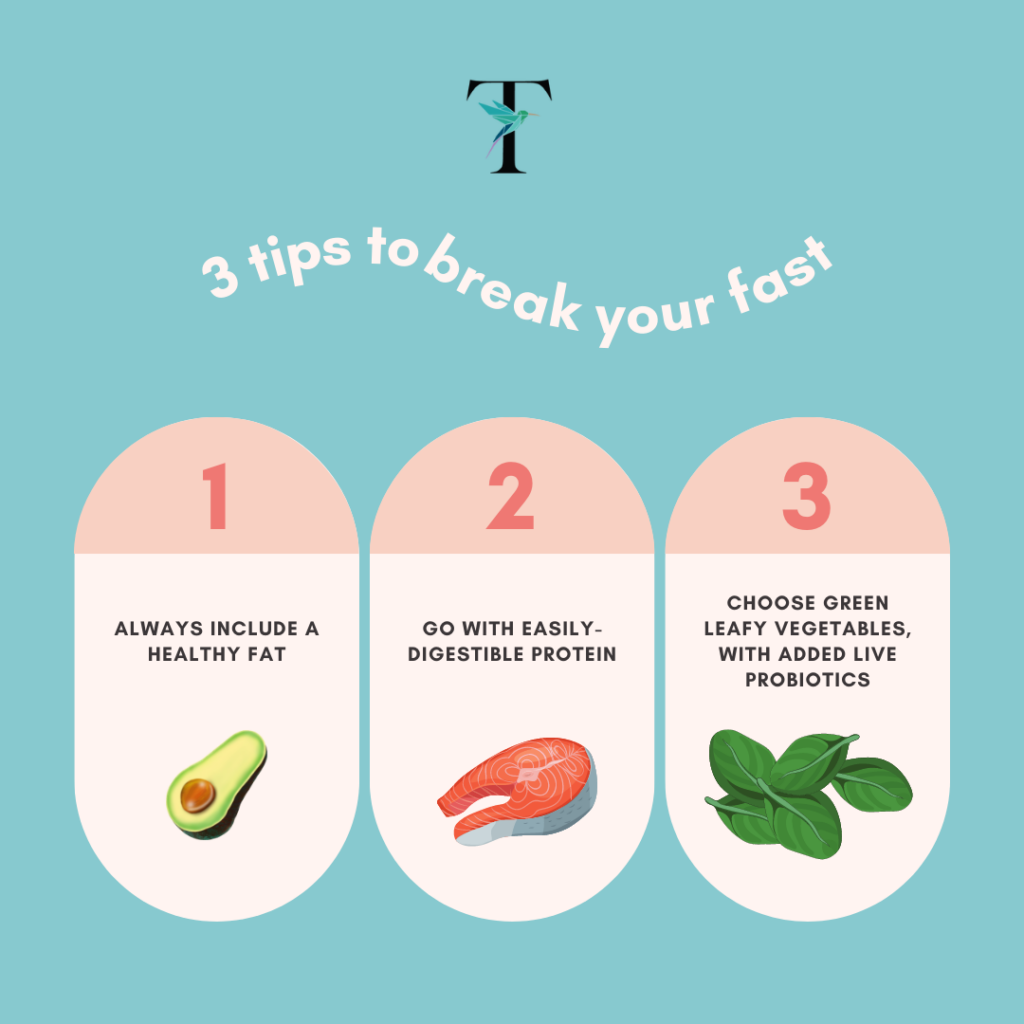

Here are 5 practical tips to ease into intermittent fasting:
- Start time-restricted feeding (TRF)
Alternate between 12 hours of fasting overnight, with a corresponding 12 hour eating window; and 14 hours of fasting overnight, with a corresponding 10 hour eating window.
- Perform gentle, adaptive exercise like walking, pilates or yoga on the days that you fast
Remember, fasting acts as a mild stressor on the body, and so does exercise. Take it easy in the initial phases of implementing intermittent fasting until your body is well-adapted.
For athletes or those performing resistance exercise in the fasted state, chat to your dietitian about how to get adequate protein at the most ideal time to ensure maintenance of muscle mass.
- Eat most of your carbs at breakfast or lunch (if this is your first meal of the day). Eat a lower carb dinner no less than 3 hours before bedtime.
Your body is typically most sensitive to insulin in the morning, and not as good as burning carbs (blood sugar) in the evening; so is able to better go for carbs earlier in the day.
- Attempt to consume healthy, non-caloric drinks in the fasting time – like herbal teas, water or black coffee.
- Personalise your fasting approach with an integrative dietitian.
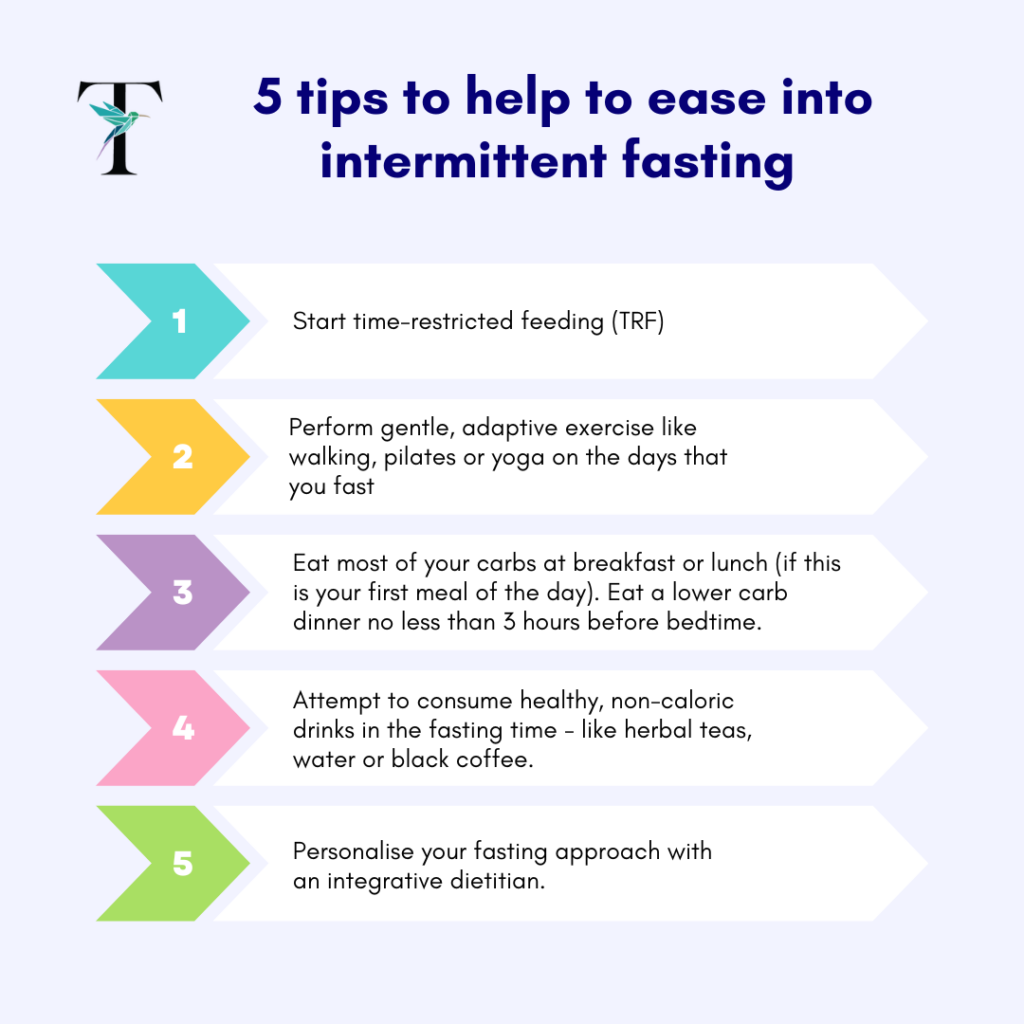
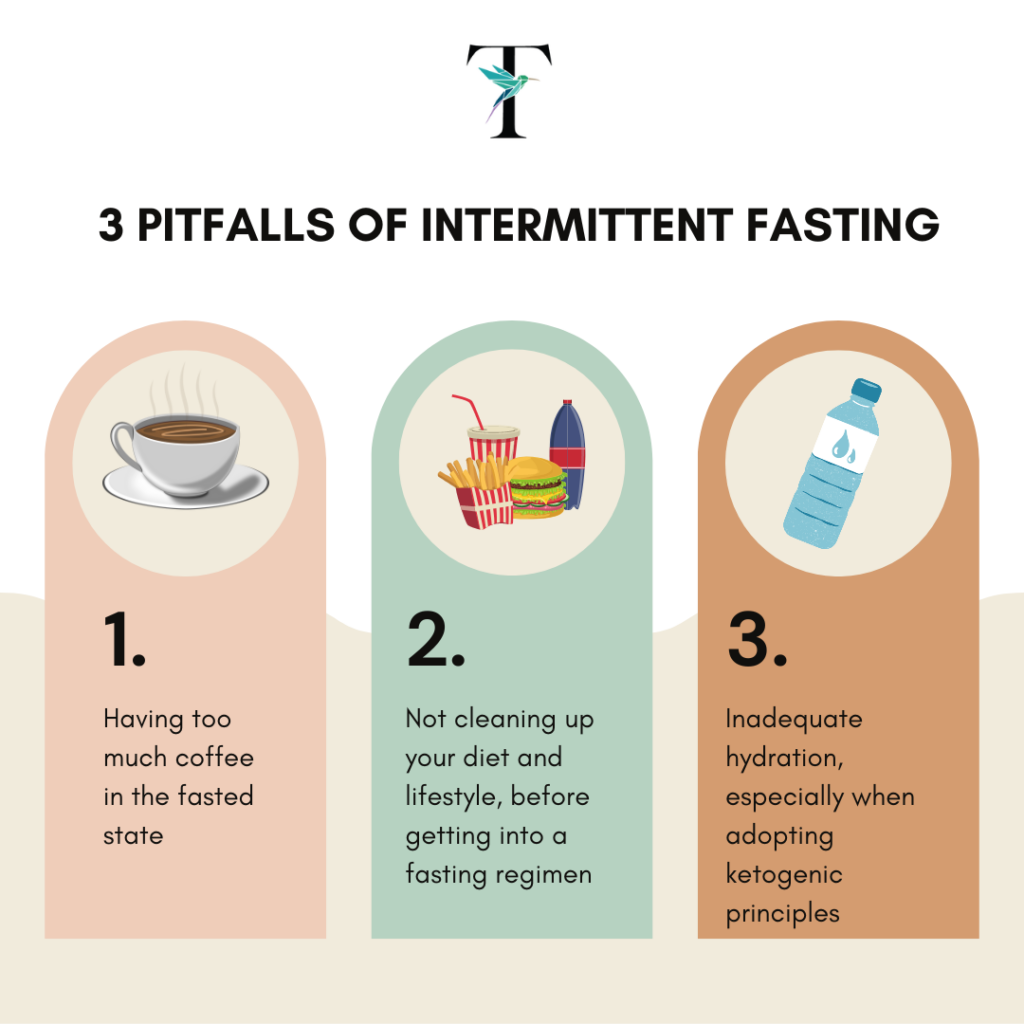
The 3 most common pit-falls of intermittent fasting
- Having too much coffee in the fasted state
For those that are caffeine-sensitive or overly stressed; caffeine can increase your stress hormone (cortisol) levels, which can increase blood sugar levels even in the absence of food!
- Not cleaning up your diet and lifestyle, before getting into a fasting regimen
Many of the powerful effects of fasting can be negated if you continue with sedentary behaviour, a diet high in inflammatory foods, and minimal sleep. Start with basics first – these are the foundations of your wellbeing.
If you’re breaking your fast with an unhealthy meal – high in sugar or processed carbs – then you’re sending your blood sugar levels on a rollercoaster. Or if you’re late night snacking, then start here.
- Inadequate hydration, especially if reducing your carbs significantly
Remain well-hydrated. Reducing carbohydrates can reduce your body’s water stores, and shift your electrolyte balance. Tip: add some Himalayan pink salt into your water to increase electrolyte intake.
Take home:
Remember, you’re not made for a cookie-cutter approach.
Your integrative dietitian will take the pieces of your puzzle – whether it be genetic testing, biomarkers such as bloods results or CGM testing, an InBody composition report and your unique clinical picture – to best ascertain the most ideal fasting regime for you.





